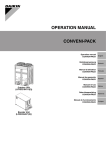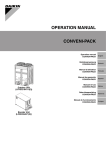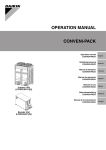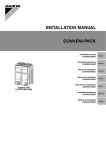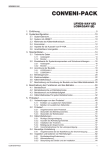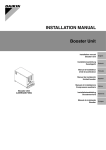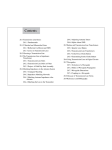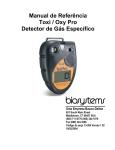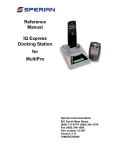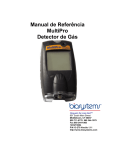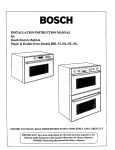Download Booster Unit INSTALLATION MANUAL
Transcript
INSTALLATION MANUAL Booster Unit Installation manual Booster Unit Installationsanleitung Zusatzgerät Deutsch Manuel d’installation Unité d'accélération Français Manual de instalación Unidad booster Español Manuale di installazione Compressore ausiliario Booster Unit (LCBKQ3AV1(E)) English Italiano Installatiehandleiding Boostereenheid Nederlands Manual de instalação Booster Portugues LCBKQ3AV1(E) CONTENTS 1. FIRST OF ALL ......................................................................... 1 1-1 Safety Precautions ........................................................... 1 1-2 Special Notice of Product.................................................. 2 1-3 Disposal Requirements ..................................................... 2 2. BEFORE INSTALLATION........................................................ 2 2-1 Standard Supplied Accessories ........................................ 2 2-2 Example of System Configuration..................................... 2 2-3 Indoor Unit Constraints ..................................................... 3 3. SELECTION OF LOCATION ................................................... 3 4. PLACING THE UNIT................................................................ 3 4-1 Handling The Unit ............................................................. 3 4-2 Installation the Unit ........................................................... 4 4-3 Draining the Unit ............................................................... 4 4-4 Installation Procedure ....................................................... 4 5. REFRIGERANT PIPING .......................................................... 4 5-1 Selection of Piping Material .............................................. 5 5-2 Protection against Contamination when Installing Pipes .................................................................. 6 5-3 Pipe Connection................................................................ 6 5-4 Connecting the Refrigerant Piping .................................... 6 5-5 Air Tight Test / Vacuum Drying ......................................... 7 5-6 Thermal Insulation for Piping ............................................ 7 6. FIELD WIRING ........................................................................ 8 6-1 Example of Wiring Entire System ..................................... 9 6-2 Procedure for Incoming Wiring ......................................... 9 6-3 Wiring Connection........................................................... 10 6-4 Checking of Device and Installation Conditions .............. 10 7. CHECKS AFTER WORK COMPLETION .............................. 10 8. REFRIGERANT REPLENISHMENT...................................... 11 9. TEST RUN ............................................................................. 11 1. FIRST OF ALL • This document is an installation manual for the Daikin Booster Unit. Before installing the unit, read this manual thoroughly, and following the instructions contained in it. After installation, do a test run to make sure the unit runs properly, and then explain how to operate and take care of the unit to the customer, using the operation manual. • Lastly, make sure the customer keeps this manual, along with the operation manual, in a safe place. • This manual does not describe how to install the indoor unit and outdoor unit. Refer to the installation manual included with the indoor unit and outdoor unit for that. 1-1 Safety Precautions Please read these “Safety precautions” carefully before installing the booster unit and be sure to install it correctly. After completing installation, conduct a trial operation to check for faults and explain to the customer how to operate the booster unit and take care of it with the aid of the operation manual. Ask the customer to store the installation manual along with the operation manual for future reference. Meaning of WARNING and CAUTION notices WARNING.....Failure to follow these instructions properly may result in personal injury or loss of life. CAUTION......Failure to observe these instructions properly may result in property damage or personal injury, which may be serious depending on the circumstances. WARNING • Ask your dealer or qualified personnel to carry out installation work. Do not attempt to install the booster unit yourself. Improper installation may result in water leakage, electric shocks or fire. English Booster Unit Installation manual • Maintenance personnel of the manufacturer or equivalent skilled personnel should install this unit. • Install the booster unit in accordance with the instructions in this installation manual. Improper installation may result in water leakage, electric shocks or fire. • When installing the unit in a small room, take measures against to keep refrigerant concentration from exceeding allowable safety limits in the event of refrigerant leakage. Contact the place of purchase for more information. Excessive refrigerant in a closed ambient can lead to oxygen deficiency. • Be sure to use only the specified accessories and parts for installation work. Failure to use the specified parts may result in the unit falling, water leakage, electric shocks or fire. • Install the booster unit on a foundation strong enough to withstand the weight of the unit. A foundation of insufficient strength may result in the equipment falling and causing injury. • Carry out the specified installation work after taking into account strong winds, typhoons or earthquakes. Failure to do so during installation work may result in the unit falling and causing accidents. • Make sure that a separate power supply circuit is provided for this unit and that all electrical work is carried out by qualified personnel according to local laws and regulations and this installation manual. An insufficient power supply capacity or improper electrical construction may lead to electric shocks or fire. • Make sure that all wiring is secured, the specified wires are used, and that there is no strain on the terminal connections or wires. Improper connections or securing of wires may result in abnormal heat build-up or fire. • When wiring the power supply and connecting transmission wiring, position the wires so that the control box lid can be securely fastened. Improper positioning of the control box lid may result in electric shocks, fire or the terminals overheating. • If refrigerant gas leaks during installation, ventilate the area immediately. Toxic gas may be produced if the refrigerant gas comes into contact with fire. • After completing installation, check for refrigerant gas leakage. Toxic gas may be produced if the refrigerant gas leaks into the room and comes into contact with a source of fire, such as a fan heater, stove or cooker. • Be sure to switch off the unit before touching any electrical parts. • Do not directly touch refrigerant that has leaked from refrigerant pipes or other areas, as there is a danger of frostbite. • Do not allow children to climb on the outside unit and avoid placing objects on the unit. Injury may result if the unit becomes loose and falls. • Be sure to earth the booster unit. Do not earth the unit to a utility pipe, lightning conductor or telephone earth lead. Imperfect earthing may result in electric shocks or fire. A high surge current from lightning or other sources may cause damage to the booster unit. • Be sure to install an earth leakage breaker. Failure to install an earth leakage breaker may result in electric shocks or fire. CAUTION • While following the instructions in this installation manual, install drain piping to ensure proper drainage and insulate piping to prevent condensation. Improper drain piping may result in indoor water leakage and property damage. 1 • Install the indoor and outdoor units, power cord and connecting wires at least 1 meter away from televisions or radios to prevent picture interference and noise. (Depending on the incoming signal strength, a distance of 1 meter may not be sufficient to eliminate noise.) • Do not install the booster unit in the following locations: 1. Where there is a high concentration of mineral oil spray or vapour (e.g. a kitchen). Plastic parts will deteriorate, parts may fall off and water leakage could result. 2. Where corrosive gas, such as sulphurous acid gas, is produced. Corroding of copper pipes or soldered parts may result in refrigerant leakage. 3. Near machinery emitting electromagnetic radiation. Electromagnetic radiation may disturb the operation of the control system and result in a malfunction of the unit. 4. Where flammable gas may leak, where there is carbon fiber or ignitable dust suspensions in the air, or where volatile flammables such as paint thinner or gasoline are handled. Operating the unit in such conditions may result in fire. 5. Vehicles, ships, or other places that generate vibration or cause the booster unit to move. The booster unit may malfunction or cause oxygen deficiency accidents as a result of refrigerant leakage. 6. Places with excessive voltage fluctuations. The booster unit may malfunction. 7. Places where fallen leaves accumulate or weeds grow thick. 8. Places that become small animals’ shelter. Small animals coming in contact with electrical parts can cause malfunctions, smoke, or ignition. • The booster unit is not intended for use in a potentially explosive atmosphere. [DESIGN PRESSURE] Since design pressure is 3.8MPa or 38bar (for R407C units : 3.3MPa or 33bar), the wall thickness of pipes should be more carefully selected in accordance with the relevant local and national regulations. 1-3 Disposal Requirements Dismantling of the unit, treatment of the refrigerant, oil and eventual other parts, should be done in accordance with the relevant local and national regulations. 2. BEFORE INSTALLATION CAUTION • When installing the indoor unit and the outdoor unit, refer to the installation manual provided for the indoor unit and the outdoor unit. • Optional accessories are required for the installation of the product. Refer to the information on optional accessory. 2-1 Standard Supplied Accessories The following accessories are included. The storage location of the accessories is shown in the figure. Note Do not throw away any of the accessories until installation is complete. Name Clamp Manual Drain socket Quantity 3 pcs. 1 pc. 1 pc. 1-2 Special Notice of Product This booster unit comes under the term “appliances not accessible to the general public”. [CLASSIFICATION] • This booster unit comes under the term “appliances not accessible to the general public”. • Follow the showcase to be connected for the climate class. [EMC CHARACTERISTICS] This System is a class A product. In a domestic environment this product may cause radio interference in which case the user may be required to take adequate measures. [REFRIGERANT] Important information regarding the refrigerant used This product is factory charged with N2. The refrigerant system will be charged with fluorinated greenhouse gases covered by the Kyoto Protocol. Do not vent gases into the atmosphere. Refrigerant type : R410A (1) 1975 GWP value : (1) GWP = global warming potential ∗ Values are indicated in F-gas regulations (EC) No.842/2006, Annex I, Parts 1 and 2. • The refrigerant R410A requires strict cautions for keeping the system clean, dry and tight. Read the chapter “REFRIGERANT PIPING” carefully and follow these procedures correctly. A.Clean and dry Foreign materials (including mineral oils such as SUNISO oil or moisture) should be prevented from getting mixed into the system. B.Tight Take care to keep the system tight when installing. R410A does not contain any chlorine, does not destroy the ozone layer, and does not reduce the earth’s protection against harmful ultraviolet radiation. R410A can contribute slightly to the greenhouse effect if it is released. • Since R410A is a mixed refrigerant, the required additional refrigerant must be charged in its liquid state. If the refrigerant is charged in a state of gas, its composition changes and the system will not work properly. 2 Installation Manual Shape Name Drain receiver Hole cap Quantity 1 pc. 4 pcs. Shape 2-2 Example of System Configuration Name Outdoor unit Booster unit Shape Indoor unit Name Refrigeration Air-conditioner Blower coil Showcase Shape Remote conControl Warning troller (for panel airpanel Showcase (Defrost) conditioner) Indoor unit Name Freezer Blower coil Shape English <When installed as a single unit> ≥500mm Piping slot Front side ≥500mm Front side ≥200mm ≥500mm ≥500mm ≥200mm Booster unit ≥500mm 1, 2 1 2 ≥500mm ≥500mm ≥500mm <When installed in serial> Installation manual Clamps 2-3 Indoor Unit Constraints m 1.5m or m ore 1. 5m or m or e 1.5m Power supply 1.5 or Control panel Alarm panel or mo re Booster unit Control panel mo re 1.5m or more Power supply re mo Select a location for installation that meets the following conditions. Get the customer’s permission. Indoor unit Power supply or SELECTION OF LOCATION Unit cooler Power supply m 3. CAUTION 1.5 • The design pressure for the indoor unit is 2.5 MPa or more. • Install an R410A mechanical thermostatic expansion valve on each indoor unit. • Insulate the feeler block of the mechanical thermostatic expansion valve. • Install an R410A solenoid valve on the primary side of the mechanical thermostatic expansion valve (Max. operating differential pressure of 3.5 MPa [35 bars] or over) described above for each indoor unit. • Install a filter on the primary side of the solenoid valve described above for each indoor unit. Determine the filter mesh count based on the size specified by the solenoid valve and mechanical thermostatic expansion valve being used. • Route the path to the indoor unit heat exchanger so that the flow of refrigerant is from top to bottom. • When installing a number of indoor units, be sure to install them at the same level. • Use the electric heater defrosting as the defrosting type. Hot-gas defrosting models cannot be used. 1m or e or m 1m ore m or Remote controller Power supply r more 1.5m o 1.5m or more 1.5m or more ore 1.5m or m Showcase 1. An inverter booster unit may cause electronic noise generated from AM broadcasting. Examine where to install the main booster unit and electric wires, keeping proper distances away from stereo equipment, personal computers, etc. Particularly for locations with weak reception, ensure there is a distance of at least 3 meters for indoor remote controllers, place power wiring and transmission wiring in conduits, and ground the conduits. 2. If condensate may drip on downstairs (or walkway) depending on the floor condition, take a measure such as the installation of drain pan kit (sold separately). 3. The refrigerant R410A itself is nontoxic, nonflammable and is 1. There is no danger of fire due to leakage of inflammable gas. 2. Select the location of the unit in such a way that the sound gener- safe. If the refrigerant should leak however, its concentration may exceed the allowable limit depending on room size. Due to this it could be necessary to take measures against leakage. See “Engineering Data” for details. ated by the unit disturb anyone. 3. The foundation is strong enough to support the weight of the unit and the floor is flat to prevent vibration and noise generation. 4. The piping length between the booster unit and outdoor unit or between the booster unit and indoor unit may not exceed the allowable piping length. (Refer to “REFRIGERANT PIPING”) 5. When installing the unit outdoors, install it preferably in a location that is not exposed to rain. 6. The space around the unit is adequate for servicing and the minimum space for air inlet and air outlet is available. (See the “Installation Space Examples” for the minimum space requirements.) Installation Space Examples • During installation, install the units using the most appropriate of the patterns shown in the following figure for the location in question, taking into consideration human traffic and wind. • As regards space in front of the unit, consider the space needed for the local refrigerant piping when installing the units. • If the work conditions in the following figure do not apply, contact your dealer or Daikin directly. 4. PLACING THE UNIT 4-1 Handling the Unit 1. Decide on the transportation route. 2. If hanging the unit, use a cloth sling to prevent damaging the unit. Keeping the following points in mind, hang the unit following the procedure shown in the following figure. • Use the slings bearing product mass enough. • Lift the unit with 2 belts of the at least 4m long. • Put cushion cloth where the slings contact the casing. • Lift the product with cave at the product center of gravity position. If using the handle of unit, carry the unit slowly with having the handle. Belt sling Belt sling Cushion cloth Handle English Hang on the edge of the bottom plate. 3 4-2 Installation the Unit If the hose is long and hangs, be careful not to bend it halfway through. • Make sure the unit is installed level on a sufficiently strong base to prevent vibration and noise. • Secure the unit to its base using foundation bolts. (Use four commercially available M8-type foundation bolts, nuts, and washers.) • The foundation bolts should be inserted 20 mm. 4 Drain socket Booster unit 20 ≥300mm Drain hose Take it out down If installing a drain hose directly to the booster unit, reserve the space described above. Foundation bolt allowance 20 5. To Piping Work Contractors • Do not use flux at the time of brazing and connecting refrigerant pipes. Use phosphorous copper brazing filler metal (BCuP-2), which does not require flux. Chlorine-based flux causes piping corrosion. Furthermore, if fluoride is contained, the flux will have adverse influences on the refrigerant piping line, such as the deterioration of refrigerating machine oil. 680 180 320 650 CAUTION • All field piping must be installed by a licensed refrigeration technician and must comply with relevant local and national regulations. Dimension of booster unit and foundation bolt position (Unit: mm) [Precautions for reuse of existing refrigerant piping / heat exchangers] Note • When installing on a roof, make sure the roof floor is strong enough and be sure to water-proof all work. • Make sure the area around the machine drains properly by setting up drainage grooves around the foundation. Drain water is sometimes discharged from the booster unit when it is running. • If the booster unit is of brine damage Resin resistant type, use nuts provided with washers resin washers to secure the product to the foundation bolts (see the illustration on the right-hand side). The rustproof effect of the nut will be lost if the coatings on the tightening portions of the nuts come off. • Use the drain pan kit when using indoors. <Model> BWC63A2 Ensure that sufficient drainage is supplied by following the guidelines below as necessary when using outdoors. 4-3 Draining the Unit • For drainage work of the unit, install piping to ensure complete drainage. • Condensation may form on the bottom frame depending on the condition of the installation location. If the unit is installed in a poorly drained location, install an additional drain pan (optional accessory). • Check drainage of the drain pan after completing the installation work and make sure that the water runs smoothly. 4-4 Installation Procedure 1. Fit the drain holder to the top B D of the drain socket prong. 2. Fit the drain socket in drain hole-A of the bottom frame of the unit and turn it about 40 degrees clockwise. 3. Plug hole caps in other drain holes (B-E) from the underside to prevent water from leaking. A2 C E Drain hole position Drain socket 1 Drain receiver 4. Connect the hose to the drain socket using a commercial plastic hose (I.D. 25 mm) and a hose band. 4 REFRIGERANT PIPING 3 Hole cap Keep the following points in mind for the reuse of existing refrigerant piping / heat exchangers. A malfunction may result if there is deficiency. • Do not use the existing piping in the following cases. Perform new piping instead. • The piping is different in size. • The strength of the piping is insufficient. • The compressor of the booster unit previously used caused a malfunction. An adverse influence of residual substances, such as the oxidation of refrigerant oil and the generation of scale, is considered. • If the indoor unit or outdoor unit is disconnected from the piping for a long time. The intrusion of water and dust into the piping is considered. • The copper pipe is corroded. • The refrigerant of the booster unit previously used was other than R410A (e.g., R404A / R507 or R407C). The contamination of the refrigerant with heterogeneity is considered. • If there are welded connections midway on the local piping, make gas leakage checks on the welded connections. • Be sure to insulate the connection piping. The liquid and gas pipe temperatures are as follows: Liquid pipe arrival minimum temperature: 5°C (For outdoor unit) -10°C (To indoor unit) Gas pipe arrival minimum temperature: -45°C (For indoor unit) 100°C (To outdoor unit) (Max. temperature) In the case of thickness insufficiency, add additional insulation material or renew the existing insulation material. • Renew the insulation material if the insulation material is degraded. Keep the following points in mind for the reuse of existing heat exchangers • Units with insufficient design pressure (since this product is an R410A unit) require a lower-stage design pressure of 2.5 MPa [25 bars]. • Units for which the path to the heat exchanger has been routed so that the flow of refrigerant is from bottom to top • Units with copper tubing or fan corrosion • Units that may be contaminated with foreign matter such as rubbish or other dirt English 5-1 Selection of Piping Material • Make sure that the inner side and outer side of the piping used is clean and free of contaminants, such as sulphur, oxide, dust, chips, oil and fat, and water. It is desirable that the maximum oil adhesion in the piping is 30 mg per 10 m. • Use the following type of refrigerant piping. Material: Seamless phosphorus deoxidized copper tube (C1220T-O for a maximum outer diameter of 15.9 mm and C1220T-1/2H for a minimum outer diameter of 19.1 mm) Refrigerant piping size and wall thickness: Decide the size and thickness from the following table. (This product uses R410A. The withstand pressure of O type may be insufficient if it is used for piping with a minimum diameter of 19.1 mm. Therefore, be sure to use 1/2 H type with a minimum thickness of 1.0 mm. If O type is used for piping with a minimum diameter of 19.1 mm, a minimum thickness of 1.2 mm will be required. In that case, be sure to perform the blazing of each joint.) • Be sure to perform piping work within the range specified in the following table. <Refrigerant piping size> Piping size (O. D. × min. thickness)(mm) LCBKQ3AV1(E) Liquid piping inlet, outlet (Note 1) (Note 2) φ6.4×0.8 (O type) Suction piping (Note 1) (Note 2) φ15.9×1.0(O type) Discharge piping (Note 1) φ9.5×0.8(O type) (Note 1) Liquid piping inlet (Main liquid piping between booster unit and outdoor unit) Liquid piping outlet (Between booster unit and refrigeration showcase) Suction piping (Between booster unit and refrigeration showcase) Discharge piping (Main gas piping between booster unit and outdoor unit) (Note 2) If the size of the connection pipe of the refrigerating showcase exceeds that of the branch pipe shown in the table on the left, install piping near the refrigerating showcase. <Refrigerant piping length and permissible difference in height> Refer to the installation manual of the outdoor unit for the indoor unit. Max. permissible one way piping length (equivalent length) a + b + c + d ≤ 130m (d is d1, d2, or e whichever is longer) Max. branch piping length (actual length) g ≤ 30m (d is d1, d2, or e whichever is longer) b + f ≤ 30m b + c + d ≤ 30m Between booster unit and refrigeration showcase (equivalent length) i ≤ 30m Max. difference in height between booster unit and refrigeration showcase (refer to the right figure) 0 ≤ H ≤ 10m (Refer to the right figure) Booster Unit Showcase H Floor <Example of piping connection> <No. of connection of booster unit> Indoor unit (Air-conditioning) Outdoor unit LRYEQ16AY1 Max. no. of connection of booster unit Refrigeration showcase a i Unit cooler (Refrigeration) e g f b c 2 Booster unit Freezer showcase i Booster unit Freezer showcase d1 d2 English 5 Protect the piping to prevent moisture, dirt, dust, etc. from entering the piping. Outdoor Indoor Installation period Protection method More than a month Pinch the pipe Less than a month Regardless of the period Piping length shall be 30 m or less. Pinch or tape the pipe Note Exercise special caution to prevent dirt or dust when passing piping through holes in walls and when passing pipe edges to the exterior. 5-3 Pipe Connection • Be sure to perform nitrogen permutation or nitrogen blow when brazing. Create a trap Refrigeration showcase Nitrogen Nitrogen Brazing without performing nitrogen permutation or nitrogen blow into the piping will create large quantities of oxidized film on the inside of the pipes, adversely affecting valves and compressors in the refrigerating system and preventing normal operation. • The pressure regulator for the nitrogen released when doing the 2 brazing should be set to 0.02 MPa (about 0.2kg/cm :Enough to feel a slight breeze on your cheek). Note Do not use anti-oxidants when brazing the pipe joints. Residue can clog pipes and break equipment. 5-4 Connecting the Refrigerant Piping CAUTION • Do not connect an onsite piping to an incorrect one. Wrong connection will cause a malfunction. Remove the piping slot cap before connecting the pipe. A Liquid piping inlet Connect the pipe to the liquid pipe (refrigeration) of the outdoor unit. B Liquid piping outlet Connect the pipe to the liquid pipe of the refrigeration showcase. 2 When the outdoor unit is above the booster unit Create a trap Booster unit Outdoor unit Booster unit Operation Method of Shutoff Valves Follow the instructions below when operating each shutoff valve. CAUTION • Do not open the shutoff valve until the steps specified in “6-4 Checking of Device and Installation Conditions” is completed. Do not leave the shutoff valve opened without turning the power on, otherwise refrigerant may be condensed in the compressor and the insulation of the main power supply circuit may be degraded. • Be sure to use an exclusive tool to handle the shutoff valve. The shutoff valve is not of back sheet type. Excessive force imposed may break the valve. • Use a charge hose when using the service port. • Make sure that there is no refrigerant gas leakage after the valve cover and cap are securely tightened. 〈Tightening torque〉 Check with the following table the sizes of shutoff valves incorporated by each model and the tightening torque values of the respective shutoff valves. Shutoff valve sizes Liquid side shutoff valve φ9.5 Gas side shutoff valve φ9.5 C Suction pipe Connect the pipe to the gas pipe of the refrigeration showcase. Service port D Discharge pipe Connect the pipe to the gas pipe (refrigeration ) of the outdoor unit. Valve cover • Do not let the onsite piping contact other piping, the bottom frame and the side panel of the product. Precautions for piping • Always connect the piping within the range of the max. permissible piping length and the permissible difference in height. • Bend the pipe allowing for a possibly large diameter. Do not bend the pipe repeatedly. • Install a gauge joint to install the pressure sensor on the inlet and outlet pipes of the booster unit when connecting the AIRNET system (Refer to the Service Manual for details). Connect from the upper part of the main pipe To prevent the unit from oil and liquid refrigerant flowing in from the main pipe while the booster unit is stopped • Create a trap on the gas pipe at 5 m intervals if the booster unit is located below the outdoor unit (to ensure the smooth return of oil in the riser pipe (Refer to Figure 2 below)). Regulator Taping Handy valve Main gas pi outdoor un ping of (refrigeratioitn) • Create a trap on the gas pipe at 5 m intervals if the outdoor unit is located above the booster unit (to ensure the smooth return of oil in the riser pipe (Refer to Figure 1 below)). 1 When the refrigeration showcase is below the booster unit Refrigerant pipe Location to be brazed A Liquid B Liquid piping outlet piping outlet C Suction Booster D Discharge piping piping unit About 5m Place Set the piping such that it slants downward. Refer to the Refrigeration pipe diameter of showcase the showcase About 5m 5-2 Protection against Contamination when Installing Pipes Hexagon hole Sealing part Shutoff valve sizes φ9.5 Shaft Tightening torque N•m (closes clockwise) Shaft (valve body) 5.4~6.5 Hexagon wrench: 4mm Valve cover Service port 13.5~16.5 11.5~13.9 〈Opening method〉 1. Remove the valve cover and turn the shaft anticlockwise with a hexagon wrench. 2. Turn the shaft until the shaft stops. 3. Tighten the valve cover securely. Refer to the above table for the tightening torque according to the size. 6 English 〈Closing method〉 1. Remove the valve cover and turn the shaft clockwise with a hexagon wrench. 2. Tighten the shaft until the shaft comes in contact with the sealing part of the valve. 3. Tighten the valve cover securely. Refer to the above table for the tightening torque according to the size. 〈Handling Precautions for Valve Cover〉 • Be careful not to damage the sealing part. • At the time of mounting the valve cover, apply a screw lock agent to the screw thread. • Do not apply a screw lock agent (for flare nut use) to the sealing part. • Be sure to tighten the valve cover securely after operating the valve. Refer to “Operation Method of Shutoff Valves” for the tightening torque of the valve. Screw thread Apply a screw lock agent Valve cover Sealing part Not apply a screw lock agent Shutoff valve Part of mounting the valve cover. 〈Handling Precautions for Service Port〉 • Work on the service port with a charge hose provided with a pushing rod. • At the time of mounting the cap, apply a screw lock agent to the screw thread. • Do not apply a screw lock agent (for flare nut use) to the sealing part. • Be sure to tighten the cap securely after the work. Refer to “Operation Method of Shutoff Valves” for the tightening torque of the cap. • Vacuum drying - Refer to the installation manual of the outdoor unit. Liquid side shutoff valve port Port A 5-6 Thermal Insulation for Piping • Always insulate connection pipes and branch pipes on the discharge, suction and liquid sides. The liquid and gas pipe temperature are as follows: Liquid pipe arrival minimum temperature: 5°C (For outdoor unit) -10°C (To indoor unit) Gas pipe arrival minimum temperature -45°C (For indoor unit) 100°C (To outdoor unit) (Max. temperature) • Use a discharge pipe whose heat resistance is 120ºC or more as its maximum temperature reaches about 100ºC. Use a suction pipe and liquid pipe whose heat resistance is 80ºC as the standard specification. • Refer to the installation manual attached to the outdoor unit for the outdoor unit side. Insulation (field supply) Liquid piping inlet (between booster unit and main liquid pipe) Liquid piping outlet (between booster unit and refrigeration showcase) Suction pipe Cap Sealing part Not apply a screw lock agent Insulation (field supply) Screw thread Apply a screw lock agent Discharge pipe Connect piping up to the joint so that piping may not be exposed. (Heat resistance: 120ºC or more) CAUTION CAUTION Apply a screw lock agent to the valve cover mount and the screw thread of the service port. Otherwise, dew condensation water will intrude inside and freeze. Therefore, refrigerant gas leakage or a compressor malfunction may result from the cap deformation or damage. • Always insulate the pipe joint for onsite piping. (An exposed pipe can cause dew condensation and burn by contact.) 5-5 Air Tight Test / Vacuum Drying Ensure the following tests have been conducted after piping. • Check that the gas side and liquid side shutoff valves are open. • Air tight test - Always use the nitrogen gas. Pressurize the high pressure side (liquid side) to the design pressure (3.8MPa) of the outdoor unit and pressurize the low pressure side (suction side) to the design pressure (2.5MPa) of the indoor unit (field supplied). In this case, they shall be accepted if no pressure drop is found for 24 hours through pressurization at least 5 minutes from the port A and the liquid shutoff port shown in the right figure. Check if there are any leakage areas in the case of pressure drop. English 7 6. FIELD WIRING To Electric Engineering Contractors • A switch that allows all poles to be switched on and off from the main power supply must be installed. This switch must have a contact gap of at least 3 mm. • Be sure to install an earth leakage breaker. The product incorporates inverter equipment. In order to prevent the malfunctioning of the earth leakage breaker, make sure that the earth leakage breaker withstands harmonic interference. • Do not operate the booster unit until refrigerant piping work is completed, or otherwise the compressor will malfunction. • Do not remove any electrical components such as thermistors or sensors when connecting power supply wires or transmission wires. The compressor may malfunction if the booster unit is operated with such electrical components removed. CAUTION • All field wiring and components must be installed by a licensed electrician and must comply with relevant local and national regulations. • Be sure to use a dedicated power circuit. Never use a power supply shared by another appliance. • Never install a phase advancing capacitor. As this unit is equipped with an inverter, installing a phase advancing capacitor will not only deteriorate power factor improvement effect, but also may cause capacitor abnormal heating accident due to high-frequency waves. • Only proceed with wiring work after blocking off all power. • Always ground wires in accordance with relevant local and national regulations. • This machine includes an inverter device. Connect earth and leave charge to eliminate the impact on other devices by reducing noise generated from the inverter device and to prevent leaked current from being charged in the outer hull of the product. • Do not connect the ground wire to gas pipes, sewage pipes, lightning rods, or telephone ground wires. Gas pipes: can explode or catch fire if there is a gas leak. Sewage pipes: no grounding effect is possible if hard plastic piping is used. Telephone ground wires and lightning rods: dangerous when struck by lightning due to abnormal rise in electrical potential in the grounding. • Be sure to install an earth leakage circuit breaker. This unit uses an inverter, so install the earth leakage circuit breaker that be capable of handling high harmonics in order to prevent malfunctioning of the earth leakage circuit breaker itself. • Earth leakage circuit breaker which are especially for protecting ground-faults should be used in conjunction with main switch or fuse for use with wiring. • Electrical wiring must be done in accordance with the wiring diagrams and the description herein. • Do not operate until refrigerant piping work is completed. (If operated before complete the piping work, the compressor may be broken down.) • Never remove thermistor, sensor or etc. when connecting power wiring and transmission wiring. (If operated with thermistor, sensor or etc. removed, the compressor may be broken down.) • This product have reversed phase protection detector that only works when the power is turned on. If there exists black out or the power goes on and off which the product is operating, attach a reversed phase protection circuit. Running the product in reversed phase may break the compressor and other parts. • Attach the power wire securely. Introducing power with a missing N-phase or with a mistaken N-phase will break the unit. • Never connect the power supply in reversed phase. The unit can not operate normally in reversed phase. If you connect in reversed phase, replace two of the three phases. • Make sure the electrical unbalance ratio is no greater than 2%. If it is larger than this, the unit’s lifespan will be reduced. If the ratio exceeds 4%, the unit will shut down and an malfunction code will be displayed on the indoor remote controller. • Connect the wire securely using designated wire and fix it with attached clamp without applying external pressure on the terminal parts (terminal for power wiring, terminal for transmission wiring and earth terminal). 8 English 6-1 Example of Wiring Entire System Note:1. For Remote switch, use non-voltage contact for microcurrent (not more than 1mA, 12VDC) Note:2. Total capacity for warning, alarm : 0.5A or less at AC 220 to 240V. Capacity for operation output : 0.5A or less at AC 220 to 240V. Constant a-contact output Note:3. In case of the malfunction Electromagnetic contactor Timer for refrigeration Thermostat for inner temperature adjustment (Defrost heater) Timer for freezer Defrost completion thermostat Solenoid valve Relay Defrost lamp Earth leakage circuit breaker Integrated heat control board (Field supply) (For earth fault, overload and short-circuit protection) 3 phase 380-415V Earth leakage circuit breaker (High-frequency type) (For earth fault, overload and short-circuit protection) Freezer showcase (Note 1) Remote switch Outdoor unit Alarm panel (Note 3) Caution input (Note 3) Warning input Warning output Caution output Timer for freezer Refrigeration unit cooler Refrigeration operating output In-Out Out-Out Timer for refrigeration Refrigeration showcase Branch switch Overcurrent circuit breaker Indoor unit For freezer For refrigerator Remote controller Refrigeration showcase Booster unit AC 220-240V Earth leakage circuit breaker (High-frequency type) Freezer operation output (For earth fault, overload and shortcircuit protection) ST controller Remote switch (Note 1) Note • Use conduit for power supply wiring. • Make sure the weak electric wiring (i.e. for the remote controller, between units, etc.) and the power wiring do not pass near each other, keeping them at least 50 mm apart. Proximity may cause electrical interference, malfunctions, and breakage. • Be sure to connect the power wiring to the power wiring terminal block and secure it as described in “6-2 Procedure for Incoming Wiring”. • Do not connect the power supply to the terminal block for the transmission wiring for warning, alarm, operation output, and remote operation switch. Otherwise the entire system will be damaged. • Transmission wiring should be secured as described in “6-3 Wiring Connection”. • Secure wiring with clamp such as insulation lock ties to avoid contact with piping. • Shape the wires to prevent the structure such as the control box lid deforming. And close the cover firmly. English Warning Sensor input input Showcase interface 6-2 Procedure for Incoming Wiring • Route high voltage wiring (power supply wire, earth wire and refrigeration operation output wiring) through the wiring openings located on the side of the unit (through holes on the left side). Wiring diagram label (back of the cover of the electric accessory box) Electric wiring, earth wire (high voltage) Transmission wire (low voltage) • Route low voltage wiring (transmission wire, refrigeration operation input wiring and remote switch wire) through the wiring openings located on the side of the unit (through holes on the right side). 9 • Block the gap (shaded area shown in the figure below) with sealing material such as putty if an intrusion by small creatures is possible. Do not touch the high pressure piping in the shaded area during wiring. Gap (Block with sealing material.) 6-3 Wiring Connection High voltage wiring (Power supply wiring, Refrigeration operation output wiring, and earth wire) Power supply (1 phase 220~240V) Overcurrent circuit breaker (Earth leakage circuit breaker) Low voltage wiring (transmission wire, refrigeration operation input wiring and remote switch wire) Connect low voltage wiring between the booster unit and the outdoor unit, the booster unit and the integrated heat control board and the remote switch by referring to the figure below. <Precautions for low voltage wiring> • Never connect the 220-240V power supply to the terminal block of low voltage wiring. The entire system could be damaged. • Isolate low voltage wiring from high voltage wiring (power supply wire, refrigeration operation output wiring and earth wire) by at least 50 mm. • Always install low voltage wiring using vinyl cord with a 0.75-1.25 2 mm sheath or cable (duplex). • Install low voltage wiring within the limit described below. Exceeding the limit can cause transmission problems. Distance between the booster unit and the outdoor unit: 100 m <Connection for transmission wire and refrigeration operation input wiring> X1M REMOTE OFF ON <Outdoor unit> <Booster unit> In-Out Out-Out Out-Multi In-Out F1F2 F1F2 F1F2 T1T2 F1F2 1 2 Transmission wire Earth wire Power supply terminal block Attach the insulation sleeve X1M L N 50mm or more Refrigeration operation output wiring Power supply wire Fix refrigeration operation output wiring (S1, S2) with the attached clamp. Earth terminal Earth wire Fix power supply wiring (L/N phases) with the attached clamp • When two wires are connected to a single terminal, connect them so that the rear sides of the crimp contacts face each other. • Also, make sure the thinner wire is on top, securing the two wires simultaneously to the resin hook using the accessory clamp (1). High voltage wiring Never connect the power supply wire Refrigeration operation input wiring Refrigeration operation input wiring Low voltage wiring Transmission wire Fix low voltage wiring with the attached clamp <Connection for remote switch wire> • Set the operation switch to “Remote” as shown in the figure below to remotely start up and shut down. • Use a remote switch that has a contact assuring the minimum applicable load of DC12V/1mA. REMOTE OFF ON Remote switch ÚConstant a-contact input (between 1 and 2) Clamp (1) Terminal block Crip style terminal Wire: narrow Wire: thick 6-4 Checking of Device and Installation Conditions Be sure to check the followings. <For those doing electrical work> See “6-2 Procedure for Incoming Wiring”. Resin hook Power circuit, safety device, and cable requirements • A power circuit (see the following table) must be provided for connection of the unit. This circuit must be protected with the required safety devices, i.e. a main switch, a slow blow fuse on each phase and an earth leakage circuit breaker. • Use copper conductors only. • Use insulated wire for the power cord. • Select the power supply cable type and size in accordance with relevant local and national regulations. • Specifications for local wiring are in compliance with IEC60245. • Use wire type H05VV when protected pipes are used. • Use wire type H07RN-F when protected pipes are not used. LCBKQ3AV1 Phase and frequency Voltage Minimum circuit amp. Recommended fuses φ1, 50Hz 220-240V 15A 20A Refrigeration operation output wire specifications Electric wire thickness Max. wiring length 0.75~1.25mm 2 130m CAUTION • Refer to the “6-1 Example of Wiring Entire System” by all means when connecting the operation output wiring. A compressor failure may result if the operating output wiring is not connected. 10 1. Make sure there is no faulty power wiring or loosing of a nut. See “6-3 Wiring Connection”. 2. Has the insulation of the main power circuit deteriorated? Measure the insulation and check the insulation is above regular value in accordance with relevant local and national regulations. <For those doing pipe work> 1. Make sure piping size is correct. See “5-1 Selection of Piping Material”. 2. Make sure insulation work is done. See “5-6 Thermal Insulation for Piping”. 3. Make sure there is no faulty refrigerant piping. See “5. REFRIGERANT PIPING”. 7. CHECKS AFTER WORK COMPLETION • Make sure the following works are complete in accordance with the installation manual. Piping work Wiring work Air tight test/Vacuum drying Installation work for indoor unit (Refrigeration unit cooler, refrigeration showcase, freezer showcase, air-conditioner) Installation work for outdoor unit Drainage water English 8. REFRIGERANT REPLENISHMENT Operation the booster is not needed to replenish refrigerant. Follow the installation manual of the outdoor unit for the replenishment procedure. 9. TEST RUN • Refer to the Service Manual for other malfunction codes. • Take the following action if you find a malfunction code on the remote controller during the test run. Malfunction code E3, E4 For test run operators Do not operate the outdoor unit alone on a trial basis. Use the following procedure to perform a test run after installation work is complete for the entire system: EJ Test run procedure 1. Fully open the shutoff valves on the gas and liquid side of the outdoor unit and the booster unit. 2. Check that the electric accessory box lids of the outdoor unit, the booster unit and the indoor unit (air-conditioner, refrigeration showcase, refrigeration unit cooler) and the piping cover of the outdoor unit and the booster unit are closed. Then turn on the outdoor, the booster unit and indoor units (air conditioner, refrigeration showcase, refrigeration unit cooler). 3. Turn on the operation switch from the inspection door of the outdoor unit and the booster unit. (The outdoor fan rotates in about 10 minutes after the operation switch is turned on and the compressor starts.) L4 U1 U2 U4, UF UA 4. Push the ON/OFF button on the remote controller of the outdoor unit (air-conditioner) to operate the unit. 5. Check the sealing condition through the sight glass of the outdoor unit. In case of shortage of refrigerant, check if the refrigerant is charged to the specified level. 6. Check the following on each unit. Refrigeration showcase Refrigeration unit cooler Air-conditioner Cold air should be blowing and the temperature should decrease to the preset level. The unit should start defrosting operation by the time set on the timer. Cold air should be blowing and the temperature should decrease to the preset level. The unit should start defrosting operation by the time set on the timer. Cold air (or hot air) should be blowing. 7. Be sure to turn off the operation switch before turning off the power. Error diagnosis • Check the following if nothing is displayed on the remote controller during the test run. <Indoor unit (air-conditioner)> 1. Is the power turned on? 2. Is the wire broken or incorrectly wired (between the power, the indoor unit and the remote controller)? 3. Has the fuse on PCB melted? E2 Defect at installation Action to be taken Fully open the shutoff Shutoff valves closed valves. Check the transmission wire between the booster and the outdoor unit. Wiring error or booster mal- If the malfunction code perfunction of the transmission sists, check the LED on the wire between the booster print board (A2P) in the elecand the outdoor unit tric accessory box of the booster unit. Refer to the Service Manual for the checking method. Remove obstacles blocking The air passage is blocked. the air passage. Reverse-phase of the power Exchange two wires out of supply three power supply wires. Voltage drop Check the voltage drop. Check the connection of Wrong wiring of transmistransmission lines between sion lines between units the outdoor unit and the air conditioner. Check if the air conditioner is In the case of system disconnected as should be crepancy assembled. Electric leak See *1. *1 Set the operating switch to the “OFF” position to reset the power supply and then return the switch to the “ON” position to restart the unit. If the problem persists, refer to the Service Manual. CAUTION • Do not disconnect the power supply for 1 minute after setting the operating switch to “ON”. Electric leak detection is performed for several seconds after the operating switch is set to “ON” and each compressor starts operating, so disconnecting the power supply during that time will result in a false detection. For dealers • After the test run is finished, check that the piping cover and front panel are mounted. • At the time of delivery to the customer, use the Operation Manual and fully explain the handling of the equipment. • For precautions at the time of delivery, refer to the provided Installation Manual for each unit as well. • If you have changed the power wire and the transmission line, keep the power of the indoor unit (air conditioner, refrigeration showcase, refrigeration unit cooler) and the integrated heat control board turned on, turn off the operation switch of the outdoor units and never fail to press the push button switch (BS5) on PCB (A1P) in the electric accessory box (right) of the outdoor unit for at least 10 seconds (Open the inspection door (right) on the upper right portion of the electric accessory box and operate the push button switch (BS5) using an insulating rod). (See the right figure.) Inspection door (right) (Upper right portion of the electric accessory box) English 11 3P248411-5B EM09A056 (1002) FS















